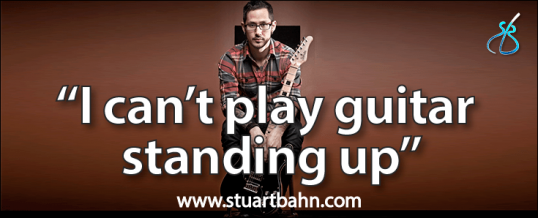
The ‘I can’t play guitar standing up’ problem
“I can’t play guitar standing up” is something I’ve heard many aspiring guitarists say; and some fairly seasoned ones too.
This article looks at what the causes of this problem are and how to fix them.
Two solutions to playing the guitar standing up
The only reason a person feels that they can’t play guitar standing up is because their guitar is in a significantly different position when they’re standing up as it is when they’re sitting down.
There are two clear solutions to this:
- Spend time developing two different guitar techniques; one for when standing; one for when sitting.
- Change the way you play so that the guitar is in the same position regardless of whether you are sitting down or standing up.
The preferred solution
There is so much to do in the world of guitar playing that it just doesn’t make sense to learn to play guitar in two different positions.
Repeating work is a poor use of time that takes away from other areas of guitar playing that you could be working on. So, go with the second solution: having the guitar in the same position when seating as standing.
In a hurry? Download a PDF of this article for later.
 Having the guitar in a consistent position
Having the guitar in a consistent position
This can be achieved in two ways:
1. Change the way you play whilst standing up.
2. Change the way you play whilst sitting down. The most common issue people have when trying to play guitar standing up, is having the strap set too long.
If a guitarist has very long arms then it might be fine for them to play with the guitar hanging very low. For many people though, a long strap will position the guitar much lower than they would have it position when seated (relative to their upper body).
With the guitar positioned too low, most guitarists will find themselves attempting to play with a severely bend wrist. This is not just bad technique; it’s potentially bad for your health.
A partial solution to having a bent wrist is to play with the guitar angled up much more vertically. However, unless you play guitar in the classical style when seated, this doesn’t solve the problem of having the guitar in two different positions; one position when sitting down and a different position when standing up.
The complete solution
The complete solution to all of this is of course to shorten the strap length and raise the guitar up.
How high?
This depends on the individual, but probably higher than you think. Seriously, go really high.
Having the guitar in a fairly high position allows you to play with your wrist in a relatively neutral position. This is better for your technique and better for your health.
Playing the guitar standing up – a video explanation
I created this short video explaining my approach to playing guitar standing up:
If you find it helpful please give it a thumbs up and subscribe to my channel to receive more guitar tips and advice:
Give it some time
Once you’ve shortened the strap and the guitar is in its new higher position, it’s going to feel unusual.
This is to be expected; it’s not what you’re used to. It might even feel ridiculous for a little while, but don’t give up so soon!
Within a day or two you’ll start to acclimatise, and after a few more days it will feel as if you’ve always played with the guitar in this position whilst standing up.
Have you got the right guitar strap?
I’ve tried a lot of guitar straps over the years. Some are just too long. Other straps can be so awkward to adjust that you may find yourself not bothering to set it correctly, and just making do with your guitar positioned too low.
The guitar strap I recommend is the Fender Black/Yellow/Brown Monogrammed Strap. These straps are very adjustable, they’re not very expensive and they last a long time.
Improvements to playing guitar sitting down
Less obviously, part of the problem could actually be how you play guitar when sitting down. The typical position for a non-classical (and right handed) guitarist is to have the guitar sitting on the right leg.
This is absolutely fine. However I’ve seen a sizeable number of guitarists play hunched severely over their guitar, with it rigidly clamped between their body, arm and leg.
Even though these guitarists may play very well in this way, it’s not transferrable to playing the guitar standing up. You can’t clamp the guitar with your body whilst standing up, and it’s certainly not good for long-term health.
This kind of posture can lead to back or shoulder pain. Even worse, tensing up muscles for hundreds of hours year after year can eventually result in nerve damage.
This is the last thing a guitarist needs. It’s better to adopt a fairly upright and relaxed posture when playing guitar; with the guitar in a position that you can also achieve when you play standing up.
Are you aware how you play sitting down?
When we play guitar we’re usually focussed on what we’re playing rather than what our bodies is doing. A good starting point is to try filming yourself whilst playing sat down. Film yourself for a few minutes so there’s time for you to get into what you’re playing.
Then, watch it back to see how you really do hold your body and guitar when you’re not thinking about it. It might not be what you expect.
If you do discover that you play the guitar hunched over, or with the guitar clamped rigidly between your body, arm and leg, I encourage you to try one of the following approaches instead.
Playing guitar seated – approach 1
Try raising the right leg up a couple of inches using a footrest, thereby raising the guitar up a little too. For most people, the guitar is in a better position for playing when raised up in this way.
Some people achieve this effect (sometimes subconsciously) by having their right foot on tip-toe and/or propped up against a chair leg. This is ok, but a footrest is more stable and allows for a more relaxed posture. If you do want to try a footrest, don’t buy a super-cheap one.
It will most likely break within a year and you’ll just end up having to buy another one. I recommend the Neewer Extra Sturdy Guitar Footrest.
Playing guitar seated – approach 2
Alternatively, and this is my preferred approach to playing sat down, try using the guitar strap whilst sitting down as well as standing up.
But don’t have the strap set so that the guitar is still on your right leg. Instead, set the strap so that the guitar is raised slightly above your right leg.
With the guitar supported only by your strap, and not your leg, you can be sure that when you play standing up, your guitar will be in the same position as this relative to your upper body.
The new normal
Whichever of the two approaches you take, give yourself a little time to get used to your new position.
Play like this consistently for a few days and this will quickly become your new default guitar position.
Both of these approaches allow you to sit with your body in a more upright position and with the guitar positioned more like it would be if we were playing the guitar standing up.
Getting use to playing guitar standing up
As with changing any technique, it can be a frustrating experience, but it’s well worth the time invested.
With the changes described above you will achieve a more consistent approach to playing guitar whilst standing up or sitting down. In time it won’t make any difference to you whether you play guitar seated or standing up, and you’ll be less likely to develop painful symptoms.
Conclusion
There is no single universal approach to positioning the guitar, and you will always find exceptions.
Ultimately though, it’s very sensible for us to try to play guitar in a consistent way, and one that will not cause trauma to our bodies in the long-term.
If you think you can’t play guitar standing up, let me reassure you that there is nothing wrong with you.
This is only a temporary problem, and one you can correct by following the approaches I’ve outlined in this article. Make these few basic changes and the phrase “I can’t play guitar standing up” will soon become a distant memory, and you will find yourself in a healthier and more productive era of your guitar playing.
If you liked this article, please consider making a donation by clicking here.
Bonus: Download a PDF of this article to print or keep on your computer, Kindle or tablet.
photo credit: joshuahoffmanphoto via photopincc
photo credit: Kyota via photopin cc
MAY
2013



About the Author:
Stuart Bahn is a professional guitarist and guitar educator in London, England.